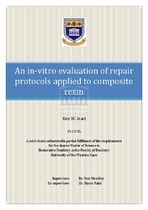| dc.description.abstract | The shift towards minimally invasive dentistry has meant that dental practitioners are now undertaking procedures that are conservative and preserve as much of the existing tooth structure as possible. Repairing composite is a more conservative way of managing damaged restorations when compared to their replacement. A number of different protocols for repairing composite restorations exist but there is little information as to which is the most effective method. Aim: The aim of this study was to evaluate the effect the following treatment procedures have on the shear bond strength of repaired composite: i. Five different repair protocols, ii. Two different types of repair composite materials and iii. Aging in artificial saliva prior to repairing. Materials and methods: Two hundred and forty composite cylinders of 5mm diameter and 5mm height made from Filtek Supreme XTE (3M ESPE, St. Paul, MN, USA) were prepared with the aid of a silicon matrix. They were then divided into two groups: a hundred and twenty of these cylinders were aged in a solution of artificial saliva for 28 days and the remaining samples were left unchanged with no aging. All the aged and non-aged composite cylinders were then randomly allocated to six groups of twenty each corresponding to the repair protocol applied. The first group from both of the aged and non-aged samples was treated by roughening the top surface with a diamond bur followed by an application of Scotchbond 1XT (3M ESPE, St. Paul, MN, USA). The second group received a surface roughening with a diamond bur,etching with 35% phosphoric acid and application of Scotchbond 1XT. The third group received an application of Scotchbond Universal (3M ESPE, St. Paul, MN, USA) and the fourth one had a single application of Tetric N-Bond Universal (Ivoclar Vivadent AG, Schaan, Liechtenstein) on its top surface. The fifth group was treated by blasting with COJET Sand (3M ESPE, St. Paul, MN, USA) particles together with an application of Scotchbond Universal. The final group was used as the control where no surface treatment was done. After the surface treatments, each of the composite samples was repaired by the addition of fresh composite in the shape of cylinders measuring 3mm in diameter and 4mm in height. This was done with the aid of a silicon matrix. Within each treatment sub-group (n=20), 10 cylinders were repaired using either Filtek Supreme XTE or Tetric N-Ceram. All two hundred and forty repaired samples were then subjected to shear bond strength testing on a Universal testing machine. Data analysis: The results of the shear bond strength tests expressed in megapascals (MPa) were recorded and analysed for the effect of three different factors under consideration. The effectiveness of the repair protocols, type of composite and aging in artificial saliva were compared using the analysis of variance. Differences within the groups were identified using a post hoc analysis. Results: The mean highest repair shear bond strength was observed when COJET Sand in conjunction with Scotchbond Universal was used to repair the aged composite blocks. There were no significant differences in the shear bond strength observed when either Filtek Supreme XTE or Tetric N-Ceram was used as the repair composites. Aging in artificial saliva led to a mean reduction of 18.08% in the repair bond strength across the six treatment groups. Conclusions: The application of a surface treatment and intermediate adhesive is crucial in improving bond strength in the composite repair interface. Repair with Filtek Supreme XTE and Tetric N-Ceram was equally effective. Aging in artificial saliva produced significantly reduced bond strength. | en_US |

